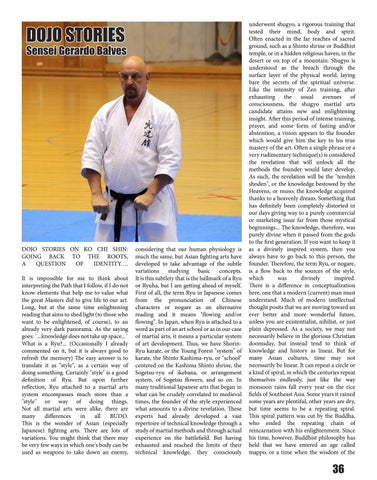DOJO STORIES
Sensei Gerardo Balves
DOJO STORIES ON KO CHI SHIN: GOING BACK TO THE ROOTS, A QUESTION OF IDENTITY…. It is impossible for me to think about interpreting the Path that I follow, if I do not know elements that help me to value what the great Masters did to give life to our art. Long, but at the same time enlightening reading that aims to shed light (to those who want to be enlightened, of course), to an already very dark panorama. As the saying goes: ¨...knowledge does not take up space...¨ What is a Ryu?... (Occasionally I already commented on it, but it is always good to refresh the memory) The easy answer is to translate it as "style", as a certain way of doing something. Certainly "style" is a good definition of Ryu. But upon further reflection, Ryu attached to a martial arts system encompasses much more than a "style" or way of doing things. Not all martial arts were alike, there are many differences in all BUDO. This is the wonder of Asian (especially Japanese) fighting arts. There are lots of variations. You might think that there may be very few ways in which one's body can be used as weapons to take down an enemy,
considering that our human physiology is much the same, but Asian fighting arts have developed to take advantage of the subtle variations studying basic concepts. It is this subtlety that is the hallmark of a Ryu or Ryuha, but I am getting ahead of myself. First of all, the term Ryu in Japanese comes from the pronunciation of Chinese characters or nogare as an alternative reading and it means "flowing and/or flowing". In Japan, when Ryu is attached to a word as part of an art school or as in our case of martial arts, it means a particular system of art development. Thus, we have ShorinRyu karate, or the Young Forest "system" of karate, the Shinto Kashima-ryu, or "school" centered on the Kashima Shinto shrine, the Sogetsu-ryu of ikebana, or arrangement system. of Sogetsu flowers, and so on. In many traditional Japanese arts that began in what can be crudely correlated to medieval times, the founder of the style experienced what amounts to a divine revelation. These experts had already developed a vast repertoire of technical knowledge through a study of martial methods and through actual experience on the battlefield. But having exhausted and reached the limits of their technical knowledge, they consciously
underwent shugyo, a rigorous training that tested their mind, body and spirit. Often enacted in the far reaches of sacred ground, such as a Shinto shrine or Buddhist temple, or in a hidden religious haven, in the desert or on top of a mountain. Shugyo is understood as the breach through the surface layer of the physical world, laying bare the secrets of the spiritual universe. Like the intensity of Zen training, after exhausting the usual avenues of consciousness, the shugyo martial arts candidate attains new and enlightening insight. After this period of intense training, prayer, and some form of fasting and/or abstention, a vision appears to the founder which would give him the key to his true mastery of the art. Often a single phrase or a very rudimentary technique(s) is considered the revelation that will unlock all the methods the founder would later develop. As such, the revelation will be the "tenshin shoden", or the knowledge bestowed by the Heavens, or muso; the knowledge acquired thanks to a heavenly dream. Something that has definitely been completely distorted in our days giving way to a purely commercial or marketing issue far from those mystical beginnings... The knowledge, therefore, was purely divine when it passed from the gods to the first generation. If you want to keep it as a divinely inspired system, then you always have to go back to this person, the founder. Therefore, the term Ryu, or nogare, is a flow back to the sources of the style, which was divinely inspired. There is a difference in conceptualization here, one that a modern (current) man must understand. Much of modern intellectual thought posits that we are moving toward an ever better and more wonderful future, unless you are existentialist, nihilist, or just plain depressed. As a society, we may not necessarily believe in the glorious Christian doomsday, but instead tend to think of knowledge and history as linear. But for many Asian cultures, time may not necessarily be linear. It can repeat a circle or a kind of spiral, in which the centuries repeat themselves endlessly, just like the way monsoon rains fall every year on the rice fields of Southeast Asia. Some years it rained some years are plentiful, other years are dry, but time seems to be a repeating spiral. This spiral pattern was cut by the Buddha, who ended the repeating chain of reincarnation with his enlightenment. Since his time, however, Buddhist philosophy has held that we have entered an age called mappo, or a time when the wisdom of the
36


















